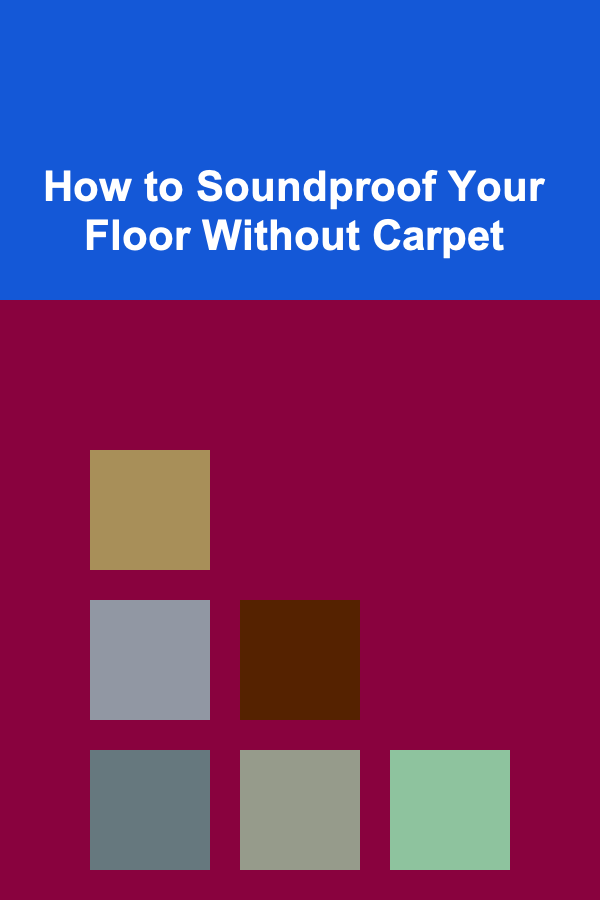
How to Soundproof a Home Office for Better Focus
ebook include PDF & Audio bundle (Micro Guide)
$12.99$10.99
Limited Time Offer! Order within the next:

Working from home offers a wide array of benefits, but it also presents unique challenges. One of the most common issues is managing noise distractions. Whether it's the hum of a busy street, the chatter of housemates, or the sounds of pets running around, background noise can significantly impact your ability to focus and be productive. A noisy home environment may lead to increased stress levels, reduced concentration, and overall lower efficiency.
Soundproofing your home office is one of the most effective ways to tackle this issue. Proper soundproofing doesn't just block unwanted noise; it also enhances your work environment, allowing you to focus better, be more creative, and feel less stressed throughout the day. In this article, we'll explore a comprehensive guide on how to soundproof a home office for better focus, covering both the theory and practical steps you can take to create the quiet, productive space you need.
Understanding the Need for Soundproofing in a Home Office
Before diving into the technical aspects of soundproofing, it's important to understand why noise is such a significant issue in a home office. Noise pollution affects both our mental and physical health, and it can have a particularly detrimental impact on our ability to focus. Studies have shown that exposure to constant noise can lead to increased stress levels, lower cognitive performance, and a decrease in productivity.
When working from home, noise sources may include:
- External noise: Traffic, construction, or street activity can seep into your workspace, disrupting your focus.
- Internal noise: Other household members, children, or pets can create background noise that hampers concentration.
- Echo and reverberation: The acoustics of your room can amplify sounds, making the environment feel louder than it is.
By soundproofing your home office, you create a controlled environment that minimizes distractions, enhances sound clarity for virtual meetings, and helps you achieve a higher level of focus.
Key Concepts of Soundproofing
Before you begin the process of soundproofing your home office, it's important to understand some key concepts in acoustics:
- Sound Transmission: This refers to how sound moves through different materials. Sound can travel through walls, ceilings, floors, and windows, which is why these surfaces need to be treated to block or absorb sound.
- Absorption vs. Blocking: Soundproofing strategies generally involve either absorbing or blocking sound. Absorptive materials (such as foam or curtains) reduce echoes and sound reflections. Blocking materials (like thick walls or specialized panels) prevent sound from entering or leaving a space.
- Frequency Range: Different materials are more effective at absorbing or blocking certain frequencies. High-frequency sounds (like voices or high-pitched noises) are easier to absorb, while low-frequency sounds (such as bass or traffic) are more challenging to block.
- Room Acoustics: The layout and materials of your room can influence the amount of sound reflection and reverberation. Rooms with hard surfaces such as tile, glass, or wood tend to amplify sound, while softer surfaces (carpet, curtains, and furniture) absorb sound more effectively.
Step-by-Step Guide to Soundproofing Your Home Office
Now that you have a basic understanding of soundproofing principles, let's walk through the steps you can take to soundproof your home office.
1. Start with Your Windows
Windows are one of the most common culprits when it comes to external noise intrusion. Sound can easily travel through glass, especially if the window is single-pane. Here are some options for improving soundproofing around your windows:
Double-Glazing or Acoustic Glass
If you're willing to invest in more substantial soundproofing, consider replacing your existing windows with double-glazed or acoustic glass. Double-glazed windows have two layers of glass with a gap between them, which helps to block out external noise. Acoustic glass, on the other hand, is specially designed to reduce noise transmission and provides a higher level of soundproofing than standard double glazing.
Window Inserts
If replacing windows isn't in your budget, window inserts are a more affordable solution. These clear acrylic panels are installed over your existing windows to create an additional layer of sound insulation. They are easy to install and can reduce noise by up to 70%.
Heavy Curtains or Window Plugs
For a less permanent solution, heavy, soundproof curtains or drapes can be installed over windows to block noise. These curtains are made from dense fabrics that absorb sound and reduce the amount of noise entering the room. If you're looking for something even more soundproofing-efficient, you can opt for window plugs made of acoustic foam or fiberglass. These can be temporarily inserted into the window frame to seal out sound.
2. Seal Gaps and Cracks in Walls and Doors
No matter how thick your walls or doors are, gaps and cracks allow noise to seep through. Sealing these gaps is an essential step in improving soundproofing.
Door Seals and Sweeps
Start by checking the seals on your doors. Many doors, especially older models, may have gaps along the sides or at the bottom where sound can pass through. Install weatherstripping or door sweeps to seal these gaps. You can find high-quality door sweeps designed specifically for soundproofing.
Acoustic Caulk
For cracks around your windows, doors, or in the walls, use acoustic caulk. This type of caulk remains flexible over time, allowing it to maintain an airtight seal that helps prevent sound from traveling through.
Soundproof Doors
If your current door is particularly thin or hollow, consider upgrading to a solid-core door. Solid-core doors are significantly better at blocking sound than hollow doors, and they can make a big difference in creating a quiet environment.
3. Add Mass to Your Walls
One of the most effective ways to soundproof a room is to increase the mass of the walls. Thicker walls are better at blocking sound transmission. While adding more layers of drywall is one option, there are several other materials that can also help:
Mass-Loaded Vinyl (MLV)
Mass-loaded vinyl is a dense, flexible material that can be applied directly to your walls to block sound. It's an effective, relatively affordable option for soundproofing. MLV is particularly useful for reducing low-frequency noise.
Acoustic Panels
Acoustic panels are designed to absorb sound and reduce room echo. They can be mounted on walls to improve room acoustics and reduce noise reverberation. Acoustic panels come in various sizes and densities, and they can be arranged in a way that provides the most effective soundproofing for your needs. Additionally, they come in a range of colors and designs, so you can improve the acoustics while enhancing the aesthetics of your home office.
Adding Additional Drywall
If you're undertaking a more significant renovation, consider adding an additional layer of drywall with a soundproofing adhesive between the layers. This extra layer increases the mass of the walls, blocking sound more effectively.
4. Focus on the Floor
Hardwood floors, tile, and concrete can amplify sound, making them less than ideal for a home office. If you have these surfaces, consider adding materials that absorb sound:
Carpets and Rugs
Adding carpets or area rugs can significantly reduce sound reflection in your office. Look for thick, plush rugs or carpets with dense padding underneath. The denser the material, the better it will absorb sound.
Acoustic Floor Underlayment
For a more permanent solution, consider installing an acoustic underlayment beneath your flooring. This material absorbs sound before it has a chance to travel through the floor, creating a quieter environment above and below the room.
5. Reduce Noise from the Ceiling
Ceilings can also be a source of unwanted noise. If you live in an apartment or share a space with others, sounds from above can be particularly bothersome.
Acoustic Ceiling Tiles
Acoustic ceiling tiles are specifically designed to absorb sound and reduce noise transmission. These tiles can be installed in suspended ceilings, and they help reduce the amount of noise that enters or leaves the room.
Adding Soundproofing Insulation
For a more comprehensive solution, consider adding soundproofing insulation to the ceiling. If you're renovating your home office, adding fiberglass or mineral wool insulation between ceiling joists can help reduce noise transmission from upstairs or surrounding rooms.
6. Use White Noise Machines or Sound Masking Systems
While soundproofing is a highly effective way to block external noise, some individuals may still struggle with noise distractions, especially if there are persistent sounds they cannot block out completely. In these cases, white noise machines or sound masking systems can help.
White Noise Machines
White noise machines generate a consistent sound that masks disruptive noises, making them less noticeable. This can be particularly helpful for masking voices or street noise. Many white noise machines also have adjustable sound settings, allowing you to find the perfect balance.
Sound Masking Systems
Sound masking systems are more advanced than white noise machines and are often used in office settings to mask conversations or other distracting sounds. These systems work by emitting a low-level background sound that blends with other noises, making them less noticeable.
7. Create a Quiet Zone
Finally, organizing your home office to create a designated quiet zone is essential. In addition to the physical soundproofing methods, you can also control your environment through how you use the space.
- Strategically place furniture: Arrange your furniture so that it helps block noise from entering your workspace. For example, position your desk away from windows or doors that face noise-heavy areas.
- Establish boundaries: If you live with others, set clear boundaries regarding noise levels during working hours. This helps ensure that everyone in the house respects your need for quiet.
Conclusion
Soundproofing your home office is an investment that pays off in terms of increased focus, reduced stress, and higher productivity. By strategically addressing potential noise sources and using effective soundproofing methods, you can create a quiet, peaceful environment that enhances your work experience. Whether you're dealing with external noise, internal distractions, or room acoustics, there are a variety of strategies you can employ to transform your home office into a haven of concentration.
Reading More From Our Other Websites
- [Horseback Riding Tip 101] Essential Riding Techniques: From Walking to Trotting with Confidence
- [Home Staging 101] How to Effectively Stage Small Spaces for Maximum Appeal
- [Home Budget 101] How to Plan for Future Home Expenses with a Long-Term Budget
- [Home Holiday Decoration 101] How to Create Beautiful Holiday Floral Arrangements
- [Sewing Tip 101] How to Build a Custom Sewing Machine Cover Using Reclaimed Wood
- [Personal Care Tips 101] How to Choose the Right Facial Scrub for Acne-Prone Skin
- [Weaving Tip 101] How to Achieve Seamless Color Gradient Effects Using Gradient Dye Lots on Merino Wool
- [Home Storage Solution 101] How to Create a Functional Entryway with Effective Storage Solutions
- [Whitewater Rafting Tip 101] Eco‑Friendly Rafting: Minimizing Your Environmental Impact on Wild Rivers
- [Home Soundproofing 101] How to Choose the Right Soundproofing Contractor

How to Build a Debt Repayment Plan That Works for You
Read More
How to Create a Productive Home Office Setup
Read More
How to Soundproof Your Floor Without Carpet
Read More
How to Use Baskets and Containers for Tidy Spaces
Read More
How to Use Neighborhood Watch Programs for Better Home Security
Read More10 Tips for Accurate Dependent Care Expense Tracking
Read MoreOther Products

How to Build a Debt Repayment Plan That Works for You
Read More
How to Create a Productive Home Office Setup
Read More
How to Soundproof Your Floor Without Carpet
Read More
How to Use Baskets and Containers for Tidy Spaces
Read More